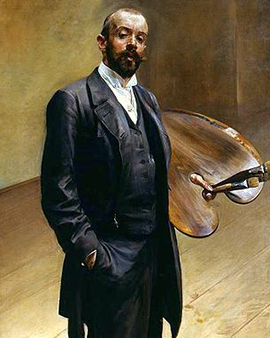The Polish painter Jacek Malczewski was born on 15 July 1854. He grew up in a poor farming family, where he was first taught by his parents. At the age of 17 he went to Cracow, where he attended grammar school. His works are classified as Symbolism and Modernism. Malczewski played a particularly important role in the field of ornamental art, which was very widespread in Poland at the time. His works are characterized by the connection of symbols with everyday reality. Malczewski intensively dealt with the political debates of his time and incorporated them into his art. Malczewski was discovered by the director and history painter Jan Mateiko during a visit as a guest student at the Cracow School of Art. Mateiko offered the young Malczewski a place at the Academy of Fine Arts.
Malczewski began with the genre of romanticism. Many works from this period are realistic history paintings and rural genre paintings. These pictures stand out due to their dark colouring. Malczewski was influenced by Arthur Grottgers with regard to these works. He then turned to symbolism, but retained the historical theme. The relationship between art and artist is at the forefront of his work. But Malczewski was also intensely preoccupied with the human being as such and with the milestones of human life, such as birth, old age and death. For about 50 years he worked on cycles and picture series in which he mixed his own symbols with traditional ones to create new meanings.
Br/>
Malczewski's Christian upbringing had a strong impact on his personality and thus on his artistic work. That is why he found his inspiration above all in ancient and Christian iconography. His immense imagination is particularly evident in his portraits. By mixing a world of fantasy and symbols with reality, he creates an ambivalence that distinguishes his originality. Malczewski represents a large number of self-portraits. In these portraits he shows himself with changing clothes or headgear. Among other things, he portrays himself as a knight, a fool or as Christ. Like his work in itself, Malczewski seems to have several faces. He died in Krakow on 8 October 1929.
×





.jpg)
.jpg)
.jpg)
.jpg)
.jpg)
.jpg)
.jpg)
.jpg)
_-_(MeisterDrucke-1464479).jpg)
_-_(MeisterDrucke-1464479).jpg)
.jpg)
.jpg)
.jpg)
.jpg)
.jpg)
.jpg)
.jpg)
.jpg)
.jpg)
.jpg)
.jpg)
.jpg)
.jpg)
.jpg)
.jpg)
.jpg)
.jpg)
.jpg)
.jpg)
.jpg)
.jpg)
.jpg)
.jpg)
.jpg)
.jpg)
.jpg)
.jpg)
.jpg)
.jpg)
.jpg)
.jpg)
.jpg)
.jpg)
.jpg)
.jpg)
.jpg)
.jpg)
.jpg)
.jpg)
.jpg)
.jpg)
.jpg)
.jpg)
.jpg)
.jpg)
.jpg)
.jpg)
.jpg)
.jpg)
.jpg)
.jpg)
.jpg)
.jpg)
.jpg)
.jpg)
.jpg)






